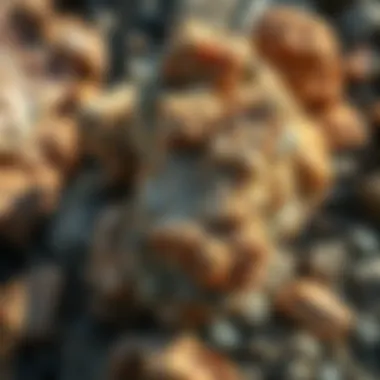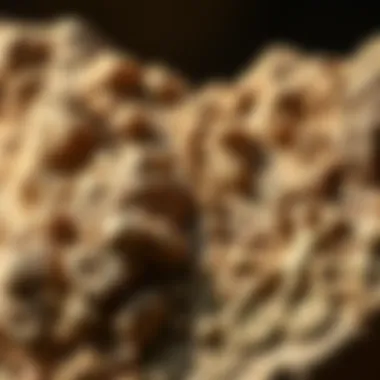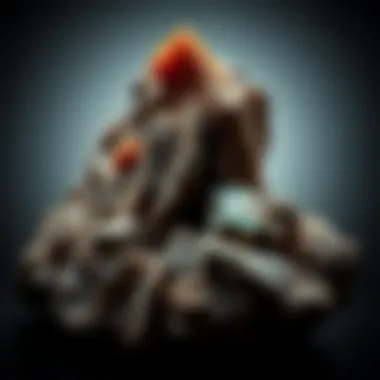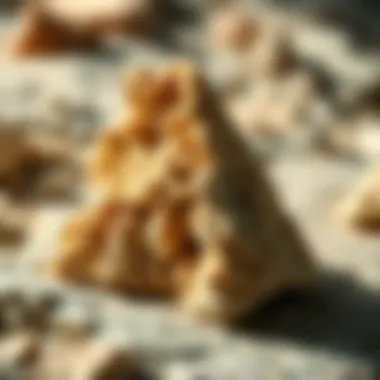Exploring the Mineral Composition of Rocks


Intro
Understanding the composition of rocks is a key puzzle piece in the vast geological landscape that forms our Earth. Whether it's the sturdy granite of a mountain or the softer sandstone by the beach, every rock tells a story, steeped in the minerals that compose it. For rock and fossil collectors, a deep understanding of this mineral makeup is not just interesting—it's vital. Being able to identify and appreciate the minerals can elevate a simple collection into a chronicle of Earth's history.
Exploring the mineral composition of rocks provides crucial insights into their formation, classification, and significance. Think of minerals as the building blocks that transform spindly elements into solid groundwork; they are the underpinnings of geological diversity. In this article, we will dissect the various types of rocks and their mineral constituents, identify the tools and techniques for evaluating rocks and fossils, discuss best practices for collecting, and delve into preservation methods that will help maintain your treasures for years to come.
This exploration caters not only to seasoned experts but also to budding enthusiasts eager to learn the ropes of geology. With plenty of strategies and wisdom shared, readers will gain confidence when navigating the world of rock composition and recognition.
Foreword to Minerals in Rocks
Understanding minerals within rocks is like peeling back the layers of an intricate puzzle that forms the very foundation of our planet. Minerals are not merely components; they provide crucial insights into the processes that sculpt the Earth’s crust. Recognizing their importance grants both the seasoned mineralogist and the budding enthusiast a comprehensive perspective on geological phenomena.
Defining Minerals
Minerals are naturally occurring solids that possess a definite chemical composition and crystalline structure. A simple way of looking at it is to think of them as the building blocks of rocks. They come in various forms and colors, each with its unique properties. For instance, quartz is hard and glassy, whereas talc is soft and greasy to touch. Such diversity is what makes the study of minerals fascinating.
An essential consideration in defining minerals is their formation. Generally, they crystallize from molten lava, precipitate from a solution, or alter due to environmental factors. Each of these processes contributes to the considerable variance seen across different mineral types, from the resilient plagioclase to the fragile calcite. This very variation becomes a key factor for geologists, enabling them to interpret the conditions under which a rock formed.
Rocks: An Overview
Rocks are aggregates of minerals, and understanding their formation is essential in revealing stories of the past. Generally classified into three primary types—igneous, sedimentary, and metamorphic—each rock type carries its own mineral signature.
- Igneous rocks form from the cooling and solidification of magma or lava. They might reveal some of the most profound geological histories, often rich in minerals like feldspar and pyroxene.
- Sedimentary rocks, on the other hand, result from the accumulation of sediment, which can include mineral fragments, organic material, and chemical deposits. Common minerals found in sedimentary rocks include quartz and calcite.
- Metamorphic rocks are formed under intense pressure and heat, which alters the minerals present. For example, limestone transforms into marble through such metamorphic processes.
The interplay between the minerals and the type of rock is crucial in understanding their characteristics and origins. By tracing these relationships, we not only appreciate the diversity of rocks but also how environmental changes influence rock formation over time.
Interconnection Between Rocks and Minerals
The relationship between rocks and minerals is deeply intertwined. Each type of rock acts like a time capsule, preserving information about its environment and history. When minerals form, they often do so under specific temperature and pressure conditions, and their presence can indicate insights about the earth's processes.
For instance, the presence of olivine in a rock sample may suggest that it originated from a volcanic environment.
Moreover, examining the composition of rocks can help inform mineral exploration. As collector communities grow, the desire to find distinct specimens becomes a driving force. Understanding the mineral composition not only aids in collection but also in the appreciation of how each piece fits into the grand narrative of geology.
In summary, this section sets the stage for a deeper dive into the world of mineral composition and its implications for both scientific inquiry and personal interest within the realm of geology.
Types of Rocks and Their Mineral Signatures
Understanding the types of rocks and their mineral signatures is pivotal for anyone delving into geological sciences or rock and fossil collecting. Different rock types not only reveal histories of formation and environmental conditions but also hold keys to the Earth's processes over millions of years. Knowledge of rock types is foundational, so one can decode the mineral composition and, in turn, realize the geological significance they possess.
Igneous Rocks: Formation and Composition
Igneous rocks are formed from the solidification of molten rock material, known as magma. When magma cools and crystallizes beneath the Earth's surface, it leads to the creation of intrusive igneous rocks like granite.
On the surface, when magma erupts as lava and cools rapidly, it produces extrusive igneous rocks, such as basalt. These rocks often have a finer-grained texture due to their rapid cooling rates.
Key Characteristics of Igneous Rocks:
- Mineral Composition: Igneous rocks primarily consist of silicate minerals like quartz, feldspar, biotite, and amphibole.
- Color: The silica content usually determines the color; rocks rich in silica tend to be lighter, while those with lesser silica appear darker.
- Texture: The texture varies widely—from the coarse-grained texture of granite to the glassy texture of volcanic glass (obsidian).
Each mineral provides insight into the cooling history and depth of formation of the igneous rock.
Sedimentary Rocks: Layers and Minerals


Sedimentary rocks are typically formed from the accumulation and compaction of mineral and organic particles. These rocks preserve a record of the Earth's surface environment, making them a vital resource for geological studies. The process often includes the weathering of pre-existing rocks, transportation of sediments, and finally deposition in layers.
Insight into Sedimentary Rocks:
- Formation Process: Sediments accumulate in bodies of water or on land, where they undergo lithification, transforming loose particles into solid rock.
- Mineral Variety: Common minerals found in sedimentary rocks include calcite, quartz, and clay minerals.
- Stratification: The layered appearance provides information on historical shifts in environmental conditions, like changes in sea level or the climatic shifts.
- Fossil Content: Many sedimentary rocks contain fossils, providing valuable clues about the Earth’s geological past.
These features make sedimentary rocks essential for both understanding Earth's history and for collectors seeking to appreciate the narratives embedded within each layer.
Metamorphic Rocks: Transformation and Mineralogy
Metamorphic rocks are the result of the alteration of existing rocks—igneous, sedimentary, or other metamorphic rocks—under heat and pressure. This transformative process can change the mineral composition, texture, and even the chemical structure of the original rock.
What to Know About Metamorphic Rocks:
- Parent Rock: Every metamorphic rock can trace its origins back to a parent rock (or protolith) that underwent metamorphism, such as limestone transforming into marble.
- Mineral Alignment: A significant feature of many metamorphic rocks is foliation, where minerals align under pressure, often giving the rock a unique banded appearance.
- Common Minerals: Key minerals in metamorphic rocks often involve garnet, schist, and slate, each hinting at the conditions of pressure and temperature during formation.
Thus, metamorphic rocks are more than just transformed stones; they reflect geological forces acting on the Earth, providing insight into its dynamic history.
Identifying Minerals within Rocks
Identifying minerals within rocks is a keystone in understanding the geological narrative of an area. By unveiling the distinctive properties and combinations of minerals, geologists gain insights into the conditions under which the rocks formed. This not only helps in interpreting the Earth's history but also provides crucial information for various practical applications, from mining to environmental remediation. Thus, accurate identification is paramount for both amateurs and professionals in the field.
Field Examination Techniques
Field examination techniques are the starting point for identifying minerals. Observing rocks in their natural settings can reveal a lot about their composition. A geologist armed with just a hand lens and a field notebook can make significant discoveries. For instance, the color, texture, and the arrangement of grains can provide immediate clues.
- Color: While not entirely reliable, color can be a helpful initial clue. For example, the rich hues of a granite can point towards certain mineral types like feldspar or biotite.
- Texture: The texture, whether coarse or fine-grained, can further distinguish entre igneous, sedimentary, and metamorphic rocks.
- Luster: Whether a mineral is shiny, dull, or glassy also plays a key role.
Additionally, a few specific field tests can further assist in identification:
- Hardness Test: Using the Mohs scale, a collector can scratch the mineral against common materials like glass or a fingernail to determine its hardness.
- Acid Test: Dropping a small amount of acid on certain minerals like calcite reveals bubbling, indicating its presence.
By employing such techniques, many enthusiasts can identify common minerals without needing extensive laboratory equipment.
Laboratory Methods of Mineral Identification
When field techniques aren't enough, laboratory methods take the lead to offer precision in mineral identification. Here, several advanced tools come into play to analyze minerals down to their atomic structure.
- X-ray Diffraction (XRD): This is the gold standard for mineral identification. It determines the crystalline structure and can distinguish between minerals that appear similar under visual inspection.
- Scanning Electron Microscopy (SEM): SEM allows for magnification at the nanoscale, helping to visualize detailed mineral structures and compositions.
- Electron Microprobe Analysis: This method uses an electron beam to analyze the elemental composition of minerals, providing quantitative data crucial for detailed studies.
These laboratory techniques complement fieldwork, making it possible for research to achieve the accuracy required for academic studies and industrial applications.
Using Optical Microscopy
Optical microscopy is another powerful technique for identifying minerals. It bridges the gap between fieldwork and comprehensive lab analysis. With polarized light microscopy, one can distinguish minerals based on their optical properties. This is particularly useful for thin sections of rock samples.
- Birefringence: Different minerals exhibit unique patterns when polarized light is passed through them. Observing these patterns can help in identifying specific minerals.
- Pleochroism: Some minerals display different colors at various angles under polarized light, aiding in distinguishing among similar-looking specimens.
Optical microscopy has a beauty of its own, as it offers vibrant visuals of mineral structures that are both scientifically and aesthetically pleasing.
By utilizing these techniques for mineral identification, collectors can deepen their understanding of the rocks they encounter and, subsequently, enhance their collection efforts.
Through exploring the nuances of mineral identification, one does not just collect rocks; rather, one becomes part of a larger story encapsulated within the Earth's crust.


For further reading on mineral identification techniques, check out Wikipedia or the US Geological Survey.
The Importance of Minerals in Geology
The exploration of minerals within geology is not merely an academic exercise; it serves as the backbone for understanding the Earth’s composition and the processes that continually reshape it. Minerals act as the key indicators of an array of geological phenomena, offering insights into the history of our planet. From the intimate interplay between tectonic plates to the environmental adjustments that follow natural catastrophes or human interventions, minerals are vital in illustrating these processes.
Minerals as Indicators of Geological Processes
Minerals can often be viewed as pages in the Earth’s history book. They tell stories of past volcanic activities, climatic changes, and even the shifts in ecological niches. For example, the presence of certain minerals like olivine and pyroxene indicates that a volcanic rock originated in high-temperature conditions, providing context about the geological environment during its formation. Conversely, minerals such as clay minerals often point to weathering processes and sedimentation in calmer waters.
- Petrographic analysis can pinpoint the exact conditions under which a rock formed, relying on the mineral assemblage found within.
- Geochemical signatures help deduce the mineral's origin, which can be crucial during fossil fuel exploration.
Understanding these indicators is invaluable to geologists who seek to reconstruct geological events. Not only are minerals fundamental in deciphering the past, but they also offer predictions about future geological activities. For instance, studying the mineral content in certain areas prone to earthquakes can alert scientists to potential risks, making the study of minerals closely tied to public safety.
"In geology, the understanding of minerals shapes our understanding of Earth’s past, guiding our navigation through its future."
Economic Importance of Mineral Resources
Minerals also play a fundamental economic role that is impossible to overlook. Their extraction and use in various industries significantly contribute to global economies. Key minerals like quartz, feldspar, and calcite are extensively mined and processed in many applications, from construction to technology. The economic implications meld seamlessly with geological studies in numerous ways:
- Construction materials: Minerals such as limestone and granite serve as essential building blocks for infrastructure.
- Energy resources: Minerals like coal and uranium are crucial for energy production, fueling not just local initiatives but entire countries.
- Technological advancement: Several modern technologies depend on rare minerals, such as lithium and cobalt, essential in batteries and electronic devices.
Furthermore, responsible mining practices hinge on geological insights, ensuring that resource extraction is sustainable and congruent with environmental preservation goals. The exploration of mineral deposits is also key to maintaining a balance between development and ecological integrity, a tightrope that today's industries must walk carefully.
For additional information on minerals and their geological relevance, consider visiting sources like Wikipedia, Britannica, or exploring communities on Reddit.
Whether traversing through geological studies or navigating the intricacies of mineral economics, the insight gleaned from the mineral composition of rocks lays the groundwork for both academic inquiry and practical application.
Mineral Classification Systems
Understanding mineral classification systems is crucial as it forms the backbone of mineralogy. These systems help scientists and enthusiasts organize and identify minerals based on shared characteristics, providing a systematic approach in studying the complex world of rocks and minerals. Without a proper classification, it would be akin to navigating a maze without a map.
The Mohs Scale of Hardness
The Mohs Scale of Hardness is a simple yet effective tool that ranks minerals based on their ability to scratch one another. Ranging from talc, the softest mineral rated at 1, to diamond, the hardest at 10, this scale serves as a fundamental reference point for geologists and collectors alike.
But why is this scale significant?
- Practicality: A collector can quickly determine a mineral's hardness by a simple scratch test using common items, like a fingernail or a copper coin.
- Identification: Hardness aids in distinguishing between similar-looking minerals. For instance, quartz (rated 7) can be differentiated from calcite (rated 3) based on its scratch resistance.
- Historical Context: This scale, devised in 1812 by Friedrich Mohs, has stood the test of time, bridging both academic settings and amateur collecting.
"The simplicity and directness of the Mohs Scale have enabled generations of mineral enthusiasts to appreciate the intricate beauty and diversity of the Earth's materials."
Mineral Families and Grouping
Minerals can be grouped into families based on chemical composition and structural features. Understanding these families allows rock collectors to not only classify their finds but also to comprehend their formation processes. Here’s a brief overview of key families:
- Silicates: The most abundant family containing silicon and oxygen, examples include quartz and feldspar.
- Carbonates: Composed primarily of carbonate ions, such as calcite and dolomite, these minerals often form in sedimentary environments.
- Oxides: Minerals like magnetite and hematite fall into this category, being formed from metal oxides.
- Sulfides: This family includes minerals like pyrite and galena, often forming through hydrothermal processes.
Understanding these families enables collectors to categorize their specimens more effectively while providing context related to their geological histories.
Crystallography and Mineral Structure
Crystallography dives into the arrangement of atoms within a mineral, which directly influences its physical properties and appearance. Mineral structure can be understood through various aspects:
- Crystal System: Various shapes, such as cubic, tetragonal, or hexagonal, categorize minerals. For example, the cubic structure of pyrite contrasts sharply with the hexagonal shape of quartz.
- Lattice Structure: The manner in which atoms bond impacts hardness, cleavage, and transparency. Covalent and ionic bond types result in drastically different minerals, giving rise to unique characteristics.
- Twining and Defects: Minerals can display twinning, where two crystals grow together, altering properties like habit and cleavage. Defects in the lattice can lead to color variations and impact other physical properties.


Minera science always evolves, emphasizing the importance of understanding the micro-level structures, which can reveal much about a mineral's history and formation.
Collecting Rocks and Minerals
Collecting rocks and minerals is not just a pastime; it’s a window into the very history of our planet. For rock and fossil enthusiasts, the thrill of discovery often outweighs the simplicity of merely collecting. Each specimen tells a unique story—its formation, environmental conditions, and the processes that shaped it over millennia. This section aims to highlight the significance of collecting, the tools you’ll need, the ethical considerations, and effective techniques for preserving and displaying your findings.
Essential Tools for Collectors
To embark on your journey as a rock and mineral collector, having the right tools is key. The landscape can be unpredictable, and the right equipment can make your efforts fruitful. Here’s a rundown of the essential tools:
- Geology Hammer: A sturdy geology hammer is indispensable. It is used to break apart rock and expose the minerals hidden within.
- Chisels: A set of chisels helps in fine-tuning your extraction. They come handy when you need more precision than your hammer provides.
- Safety Goggles: Protect your eyes from flying debris while you’re working to uncover your treasures.
- Field Guide: A geology or mineral guidebook can be your best friend, helping you identify minerals and rocks on-site.
- Magnifying Glass: This portable tool aids in examining the details of mineral compositions and identifying key characteristics.
Remember to pack a sturdy backpack because you’ll likely be carrying more than you expect!
Ethics of Rock and Mineral Collection
When it comes to collecting, integrity and respect for nature must be at the forefront. Collecting rocks and minerals shouldn’t infringe upon the Earth’s ecosystems or historical sites. Here are some important ethical considerations to keep in mind:
- Permits: Always check if you need permits for collecting in public lands or registered sites. Some areas may have restrictions to protect their geological significance.
- Leave No Trace: Consider the environmental impact. If you take a specimen, remember to leave the area as you found it. Don’t disturb the surrounding habitat unnecessarily.
- Cultural Sensitivity: Be aware of local traditions and restrictions, especially in regions with cultural significance. Collecting from sacred sites is unacceptable.
- Sustainable Practices: Avoid over-collecting. Ensure that your collecting practices do not jeopardize the local geology or its natural beauty.
Following these ethical guidelines is critical in maintaining the integrity of both the collecting community and the environments we cherish.
Preservation and Display Techniques
After a successful collecting trip, the next step is ensuring your treasures are preserved for future enjoyment. Without proper care, even the most stunning specimens can lose their luster or degrade over time. Here are some tips for preserving and displaying your rocks and minerals:
- Cleaning: Use a soft brush or cloth to remove dirt. Be cautious with water and chemicals, as some minerals can be sensitive.
- Storage: Store specimens in a cool, dry place. Avoid direct sunlight to prevent fading or altering any natural colors.
- Display Cases: Use display cases to showcase your collection. Options range from simple glass boxes to custom cabinets, allowing you to show off your finds while protecting them.
- Labeling: Create labels that document the specimen’s name, location of collection, and any unique characteristics. This not only enhances your display but also serves as a record of your collection’s history.
"A well-preserved specimen is not just a rock; it’s a story waiting to be told."
Closure
Collecting rocks and minerals offers enthusiasts an engaging and educational hobby. Equipped with the right tools, a commitment to ethical practices, and effective preservation techniques, collectors can enjoy their pastime responsibly. Moreover, the skills developed through careful collection can open new doors to understanding our planet’s geology, making each outing not just a hunt but a journey through time.
Epilogue and Future Directions in Mineralogy
In the ever-evolving field of mineralogy, understanding the mineral composition of rocks is not just academic; it holds practical implications for a variety of disciplines. Therefore, this concluding section emphasizes the significance of ongoing research and the exploration of minerals in a broader context. The relationship between rock types and their constituent minerals can illuminate patterns in geological history, offer insights into environmental changes, and even inform economic strategies for resource extraction.
Future directions in mineralogy promise to uncover further complexities in the mineralogical world. As the landscape of geology shifts with advances in research methodologies, the ability to decipher the intricate links between minerals and their host rocks will only grow in importance. This will lead to more sophisticated models of rock formation and transformation, with crucial implications for fields such as geotechnical engineering, environmental science, and even climate studies.
"Mineralogy is like a key; it can unlock the mysteries of Earth's processes and resources!"
Some critical elements shaping the future of mineralogical studies include:
- Multidisciplinary Approaches: Experts from various fields such as biology, chemistry, and materials science are collaborating on mineral research, leading to new discoveries and applications. This cross-pollination of ideas can foster innovative techniques in the study of rocks and minerals.
- Sustainability and Resource Management: As demand for natural resources grows, there's a focus on responsible mineral extraction methods. Researchers are committed to developing techniques that minimize ecological impact while maximizing the recovery of essential minerals.
- Geo-detection Technologies: Utilizing advanced tools and methods, like satellite imaging or ground-penetrating radar, are key to identifying mineral deposits and assessing geological features. These technologies can accelerate research and ensure more efficient exploration activities.
Emerging Trends in Mineral Research
The realm of mineral research is witnessing some exciting trends. From the advent of artificial intelligence in data analysis to the study of rare minerals, several factors are pushing this field forward. Artificial intelligence, in particular, is showing promise in predicting mineral compositions from large datasets, allowing scientists to focus their attention on the most promising areas for exploration and study.
On the frontlines, researchers are also assessing the role of minerals in modern materials. Lithium and rare earth elements, for example, are in high demand for technology products like smartphones and electric vehicles. The implications of researching these elements extend beyond geology and resource management; they touch directly on sustainability and emerging technology sectors.
The Role of Technology in Mineral Studies
The integration of technology in mineral studies marks a significant turning point in the understanding of rocks and their mineral content. High-resolution imaging techniques, for instance, enable researchers to observe mineral structures at the atomic level. Scanning electron microscopes and X-ray diffraction methods are just a couple of the tools enhancing mineral characterization.
Additionally, the application of spectroscopy allows scientists to analyze mineral composition non-destructively. This means that precious samples collected by rock and fossil collectors can be subjected to detailed, accurate analysis without compromising their integrity.
As technology continues to evolve, the promise of new instruments and analytical methods remains vast, paving the way for detailed studies that were once thought unattainable. Overall, the intertwining nature of rocks and minerals continues to reveal new insights into Earth's complex systems. Empowered by both past achievements and future directions, the vibrant field of mineralogy stands as a testament to humanity's intrinsic desire to explore, understand, and responsibly utilize the natural world.







